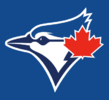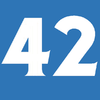Toronto Blue Jays
| Toronto Blue Jays | |||||
|---|---|---|---|---|---|
|
| |||||
| Established in 1977 | |||||
| |||||
| Major league affiliations | |||||
| |||||
| Current uniform | |||||
|
| |||||
| Retired numbers | |||||
| Colours | |||||
| Name | |||||
| |||||
| Other nicknames | |||||
| |||||
| Ballpark | |||||
| |||||
| Major league titles | |||||
| World Series titles (2) | |||||
| AL Pennants (2) | |||||
| East Division titles (6) | |||||
| Wild card berths (1) | 2016 | ||||
| Front office | |||||
| Owner(s) | Rogers Communications[2] | ||||
| Manager | John Gibbons | ||||
| General Manager | Ross Atkins | ||||
| President of Baseball Operations | Mark Shapiro | ||||
The Toronto Blue Jays are a Canadian professional baseball team based in Toronto, Ontario. The Blue Jays compete in Major League Baseball (MLB) as a member club of the American League (AL) East division. The team plays its home games at the Rogers Centre (formerly known as the SkyDome).
The "Blue Jays" name originates from the bird of the same name, and blue is also the traditional colour of two of Toronto's other professional sports teams: the Maple Leafs (ice hockey) and the Argonauts (Canadian football). In addition, the team was originally owned by the Labatt Brewing Company, makers of the popular beer Labatt's Blue. Colloquially nicknamed the "Jays", the team's official colours are royal blue, navy blue, red, and white.[3] An expansion franchise, the club was founded in Toronto in 1977. Originally based at Exhibition Stadium, the team began playing its home games at the SkyDome upon its opening in 1989. Since 2000, the Blue Jays have been owned by Rogers Communications and in 2004, the SkyDome was purchased by that company, which it renamed Rogers Centre. They are the second MLB franchise to be based outside the United States, and currently the only team based outside the U.S. after the first Canadian franchise, the Montreal Expos, relocated to Washington, D.C. after the 2004 season and became the Washington Nationals.
In the late 1970s and early 1980s, the Blue Jays went through struggles typical of an expansion team, frequently finishing in last place in its division. In 1983, the team had its first winning season and two years later, they became division champions. From 1985–1993, they were an AL East powerhouse, winning five division championships in nine seasons, including three consecutive from 1991–93. During that run, the team also became back-to-back World Series champions in 1992 and 1993, led by a core group of award-winning All-Star players, including Hall of Famer Roberto Alomar, Joe Carter, John Olerud, and Devon White. The Blue Jays became the first (and, to date, only) team outside the US to appear in and win a World Series, and the fastest AL expansion team to do so, winning in its 16th year. After 1993, the Blue Jays failed to qualify for the playoffs for 21 consecutive seasons, until clinching a playoff berth and division championship in 2015. The team clinched a second consecutive playoff berth in 2016, after securing an AL wild card position. Both years, the Jays won the AL Division Series.
The Blue Jays are one of two MLB teams under corporate ownership, with the other being the Atlanta Braves (Liberty Media).
History
1977–1994: The Pat Gillick era
1977–1981
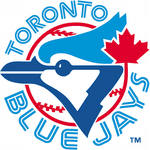
The Blue Jays played their first game on April 7, 1977 against the Chicago White Sox before a home crowd of 44,649. The game is now perhaps best remembered for the minor snowstorm which began just before the game started. Toronto won the snowy affair 9–5, led by Doug Ault's two home runs. That win would be one of only 54 of the 1977 season, as the Blue Jays finished last in the AL East, with a record of 54–107. After the season, assistant general manager Pat Gillick succeeded Peter Bavasi as general manager of the team, a position he would hold until 1994.[4]
In 1978, the team improved their record by five games, but remained last, with a record of 59–102. In 1979, after a 53–109 last place finish, shortstop Alfredo Griffin was named American League co-Rookie of the Year. In addition, the Blue Jays' first mascot, BJ Birdy, made its debut in 1979.
In 1980, Bobby Mattick became manager, succeeding Roy Hartsfield, the Blue Jays' original manager. In Mattick's first season as manager, although they remained at the bottom, Toronto almost reached the 70-win mark, finishing with a record of 67–95, a 14-win improvement on 1979. Jim Clancy led with 13 wins and John Mayberry became the first Jay to hit 30 home runs in a season.
In the strike-divided season of 1981, the Blue Jays finished in last place in the AL East in both halves of the season. They were a dismal 16–42 in the first half, but improved dramatically, finishing the 48-game second half at 21–27, for a combined record of 37–69.
1982–84
Under new manager Bobby Cox, Toronto's first solid season came in 1982 as they finished 78–84. Their pitching staff was led by starters Dave Stieb, Jim Clancy and Luis Leal, and the outfield featured a young Lloyd Moseby and Jesse Barfield. 1982 was also the Blue Jays' first season outside the bottom, as they finished sixth in the East out of seven teams.
In 1983, the Blue Jays compiled their first winning record, 89–73, finishing in fourth place, nine games behind the eventual World Series champions, the Baltimore Orioles. First baseman Willie Upshaw became the first Blue Jay to have at least 100 RBIs in a season.
The Blue Jays' progress continued in 1984, finishing with the same 89–73 record, but this time in a distant second place behind another World Series champion, the Detroit Tigers. After 1984, Alfredo Griffin went to the Oakland Athletics, thus giving a permanent spot to young Dominican shortstop Tony Fernández, who would become a fan favourite for many years.
1985: The first AL East title
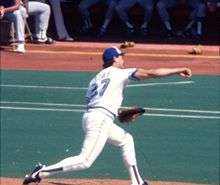
In 1985, Toronto won its first championship of any sort: the first of their six American League East division titles. The Blue Jays featured strong pitching and a balanced offence. Tony Fernández excelled in his first full season, and veteran pitcher Doyle Alexander led the team with 17 wins, including a division-clinching complete game win. Their mid-season call up of relief pitcher Tom Henke also proved to be important. They finished 99–62 (the franchise record for most wins), two games in front of the New York Yankees. The Blue Jays faced the Kansas City Royals in the American League Championship Series (ALCS), and took a three games to one lead (known as the "Drive of '85").[5] However, Kansas City won three consecutive games to win the series 4–3, on the way to their first World Series championship.
After the playoffs, AL Manager of the Year, Bobby Cox, suddenly left the Blue Jays to become general manager of the Atlanta Braves, the team he previously managed.
1986–88
With Jimy Williams now the skipper, the Blue Jays could not duplicate their success in 1986, sliding to a fourth-place tie at 86–76. Jesse Barfield and George Bell led the way with 40 and 31 home runs, respectively, while Jim Clancy, Mark Eichhorn, and Jimmy Key tied for the team wins lead with 14 each.
In 1987, the Blue Jays held a 3½-game lead with a week to go in the season, then lost their last seven in a row to finish two games back of the Detroit Tigers, getting swept on the last weekend by the Tigers. The Blue Jays finished with a 96–66 record, second best in the major leagues, but to no avail. However, George Bell (.308 AVG, 47 HR, 134 RBI) was named the AL's Most Valuable Player (MVP), the first Blue Jay to be named so.
In 1988, however, Toronto could not duplicate the successes of the previous season. They tied the Milwaukee Brewers for third in the division at 87–75, only two games behind the division champion Boston Red Sox. Still, the season had numerous highlights. First baseman Fred McGriff hit 34 home runs, and Dave Stieb had back-to-back starts in which he lost a no-hitter with two out and two strikes in the ninth inning.
1989–1991: Cito Gaston takes charge, two more AL East titles
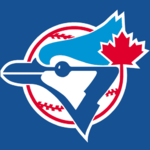
In 1989, the Blue Jays' new retractable roofed home, SkyDome, opened in mid-season. It also marked the beginning of an extremely successful five-year period for the team. In May, management fired manager Jimy Williams and replaced him with Cito Gaston, the team's hitting instructor. The club had a dismal 12–24 record at the time of the firing, but went 77–49 under Gaston to win the AL East title by two games, with an 89–73 record. On May 28, George Bell's walk-off home run, off of Chicago White Sox closer Bobby Thigpen, marked the end of the Exhibition Stadium era. The first game at the new stadium took place on June 5 against the Milwaukee Brewers; the Jays lost 5–3. In the 1989 ALCS, Rickey Henderson led the World Series champion Oakland Athletics to a 4–1 series win.
In 1990, the Blue Jays again had a strong season, but finished in second place, two games behind the Boston Red Sox. Dave Stieb pitched his only no-hitter, beating the Cleveland Indians 3–0 in front of a less than capacity crowd at Cleveland Municipal Stadium. As of 2014, it remains the only no-hitter ever pitched by a Blue Jay. During the offseason, the Blue Jays made one of the two biggest trades in franchise history, sending All-Star shortstop Tony Fernández and first baseman Fred McGriff to the San Diego Padres in exchange for outfielder Joe Carter and second baseman Roberto Alomar. The Jays also obtained centre fielder Devon White from the California Angels. These deals, particularly the trade with San Diego, were instrumental in the team's future success.
Carter, Alomar and White would prove to be extremely effective additions, as the Blue Jays again won the division in 1991, as Carter drove in Alomar for the division-winning run. Once again, however, they fell short in the postseason, losing to the Minnesota Twins, who were on the way to their second World Series victory in five seasons, in the ALCS. In 1991, the Blue Jays became the first Major League club ever to draw over four million fans in one season.
- Team record 1989: 89 wins–73 losses, W%- 0.549
- Team record 1990: 86 wins–76 losses, W%- 0.531, 2 games behind division leader
- Team record 1991: 91 wins–71 losses, W%- 0.562
1992–93: World Series champions
1992: Canada's first World Series title
After the 1991 season had ended, the Blue Jays acquired pitcher Jack Morris, who had led the Minnesota Twins to victory in the World Series by pitching a 10-inning complete game shutout in Game 7 and had been named the World Series MVP. To add veteran leadership to their explosive offence, Toronto signed Dave Winfield to be the team's designated hitter.
The 1992 regular season went well, as the Jays clinched their second straight AL East crown with a final record of 96–66, four games ahead of the Milwaukee Brewers. They also went the entire season without being swept in any series, becoming the first team in 49 years to accomplish the feat.[6] The Blue Jays met the Oakland Athletics (who had the same record as the Jays and won the AL West by six games over the defending champion Twins) in the ALCS, winning four games to two. The pivotal game of the series was Game 4, considered by many to be one of the most important games in Blue Jays history: the Blue Jays rallied back from a 6–1 deficit after seven innings, capped off by Roberto Alomar's huge game-tying two-run homer off A's closer Dennis Eckersley in the top of the ninth. This paved the way for a 7–6 victory in 11 innings, a 3-games-to-1 lead in the series and an eventual 4–2 ALCS series win.
The Blue Jays then faced the Atlanta Braves in the World Series. The Braves returned after being beaten by the Twins the previous year. The pivotal game in this series turned out to be Game 2, in which reserve player Ed Sprague hit a 9th-inning two-run home run off Braves closer Jeff Reardon to give the Blue Jays a 5–4 lead, which would hold up. After winning Game 3 thanks to Candy Maldonado's ninth inning RBI hit and Game 4 due to Jimmy Key's superb 7⅓ inning pitching effort in which he retired 15 straight batters (five innings), the Jays could not win the Series on home turf as the Braves struck back with a 7–2 win in Game 5. Game 6 in Atlanta, with the Blue Jays leading 3 games to 2, was a very close game. Toronto was one strike away from winning in the bottom of the 9th inning, 2–1,[7] but Otis Nixon singled in the tying run off the Blue Jays' closer Tom Henke. It was the first run the Toronto bullpen had given up in the series. The game was decided in the 11th inning, when Dave Winfield doubled down the left-field line, driving in two runs. The Braves would again come within one run in the bottom of the 11th, but Jays reliever Mike Timlin fielded Otis Nixon's bunt, throwing to Joe Carter at first base for the final out. The Blue Jays became the first team based outside of the United States to win the World Series. Pat Borders, the Jays' catcher, was the unlikely player who was named MVP after hitting .450 with one home run in the World Series. Oddly, Morris was acquired in large part for his reputation as a clutch postseason pitcher, but he went 0–3 in the playoffs. Morris, however, pitched well in the regular season, becoming the Blue Jays' first 20-game winner, with a record of 21–6 and an ERA of 4.04.
- Team record 1992: 96 wins–66 losses, W%- 0.593
1993: Back-to-back champs
After the 1992 season, the Blue Jays let World Series hero Dave Winfield and longtime closer Tom Henke go, but signed two key free agents: designated hitter Paul Molitor from the Milwaukee Brewers and perennial playoff success Dave Stewart from the Oakland Athletics.
In 1993, the Blue Jays had seven All-Stars: outfielders Devon White and Joe Carter, infielders John Olerud and Roberto Alomar, designated hitter Molitor, plus starting pitcher Pat Hentgen, and closer Duane Ward. In August, the Jays acquired former nemesis Rickey Henderson from the Athletics. The Blue Jays cruised to a 95–67 record, one less win than 1992 and seven games ahead of the New York Yankees, winning their third straight division title. The Jays beat the Chicago White Sox four games to two in the ALCS, and then the Philadelphia Phillies, four games to two, for their second straight World Series victory. The World Series featured several exciting games, including Game 4, played under a slight rain, in which the Blue Jays came back from a 14–9 deficit to win 15–14 and take a 3 games to 1 lead in the series. It remains the highest scoring game in World Series history. Game 6 in Toronto saw the Blue Jays lead 5–1, but give up 5 runs in the 7th inning to trail 6–5. In the bottom of the 9th inning, Joe Carter hit a one-out, three-run walk-off home run to clinch the series off of Phillies closer Mitch Williams. Only the second World Series–winning walk-off home run in the history of Major League Baseball (following Bill Mazeroski's in Game 7 in 1960), Carter's hit differed from the first in that Toronto, while not facing elimination, was trailing in the bottom of the 9th. The home run is also memorable for late Blue Jays broadcaster Tom Cheek's call:
A swing, and a belt! Left field! Way back! Blue Jays win it! The Blue Jays are World Series champions as Joe Carter hits a three-run home run in the ninth inning and the Blue Jays have repeated as World Series champions! Touch 'em all, Joe, you'll never hit a bigger home run in your life!
– Tom Cheek, late Blue Jays radio play-by-play announcer
Molitor was named the World Series MVP after hitting .500 in the series. In the regular season, three Blue Jays—Olerud, Molitor and Alomar—finished 1–2–3 for the AL batting crown, led by Olerud's franchise record .363 average. It was the first time in 100 years that the top three hitters in the league were from the same team.[4][8]
- Team record 1993: 95 wins–67 losses, W%- 0.586
1994 season
Expectations were high for the Blue Jays for the 1994 season, following back-to-back championships, but they slumped to a 55–60 record and a third-place finish (16 games back of the New York Yankees) before the players' strike. It was their first losing season since 1982. Joe Carter, Paul Molitor and John Olerud enjoyed good years at the plate, but the pitching fell off. Juan Guzmán slumped considerably from his first three years (40–11, 3.28 ERA), finishing 1994 at 12–11 with a 5.68 ERA. Three young players, Alex Gonzalez, Carlos Delgado and Shawn Green, did show much promise for the future. At the time of the strike, their fellow Canadian cousins, the Montreal Expos, had the best record in the majors, leading some to consider the possibility of a Canadian three-peat in 1994.
Labatt Breweries was bought by Belgian-based brewer Interbrew (which, in 2004, merged with AmBev to become InBev), making the Blue Jays the second baseball team owned by interests outside of North America, after the Blue Jays' expansion cousins, the Seattle Mariners (by Nintendo of America, which is the American division of the Japanese consumer electronics and software company).
- Team record 1994: 55 wins–60 losses, W%- 0.478, 16 games behind division leader
1995–2001: The Gord Ash era
1995–2000
On October 31, 1994, Pat Gillick, the longtime Blue Jays general manager, resigned and handed the reins of the team to Toronto native Gord Ash,[4] who would lead the team in its most tumultuous era yet.
In the 1995 season, the Blue Jays proved that they had lost their contending swagger of the past 12 years. Although they had most of the same cast of the World Series teams, the Blue Jays freefell to a dismal 56–88 record, last place in the AL East, 30 games behind the Boston Red Sox.
1996 was another mediocre year for the Blue Jays, despite Pat Hentgen's Cy Young Award (20–10, 3.22 ERA). Ed Sprague had a career year, hitting 36 home runs and driving in 101 runs. However, the team's 74 wins did put them in 4th place, improving over a last place finish in 1995.
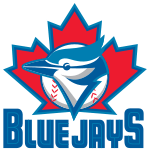
The Blue Jays started 1997 with high hopes. Not only did the Jays drastically change their uniforms, they signed former Boston Red Sox ace Roger Clemens to a $24,750,000 contract. Clemens had one of the best pitching seasons ever as he won the pitcher's Triple Crown, leading the American League with a record of 21–7, a 2.05 ERA, and 292 strikeouts. This was not enough to lead the Blue Jays to the postseason, however, as they finished in last place for the second time in three years with a record of 76–86. Cito Gaston, the longtime manager who led the team to four division titles and two World Series crowns, was fired five games before the end of the season. The season did provide a unique experience for its fans with the advent of Interleague play, when the Blue Jays faced their Canadian rival, the Montreal Expos, for the first official games between the two teams.
Before the start of the 1998 season, the Blue Jays acquired closer Randy Myers and slugger Jose Canseco. Gaston was replaced with former Blue Jay Tim Johnson, a relative unknown as a manager. Despite mediocre hitting, strong pitching led by Clemens' second straight pitching Triple Crown (20–6, 2.65 ERA, 271 strikeouts) sparked the Blue Jays to an 88–74 record — their first winning season since 1993. However, this was only good enough to finish a distant third, 26 games behind the New York Yankees, who posted one of the greatest records in all of baseball history at 114–48. They were, however, in contention for the wildcard spot until the final week.
Before the 1999 season, the Blue Jays traded Clemens to the Yankees for starting pitcher David Wells, second baseman Homer Bush and relief pitcher Graeme Lloyd. They also fired manager Tim Johnson during spring training after he lied about several things (including killing people in the Vietnam War) to motivate his players. The Blue Jays had initially been willing to stand by Johnson. A blizzard of questions about his credibility during spring training, however, led Ash to fire him less than a month before opening day. Johnson was replaced with Jim Fregosi, who managed the Phillies when they lost to the Blue Jays in the 1993 World Series. The offence picked up somewhat in 1999, but the pitching suffered without Clemens, as the Blue Jays finished at 84–78, in third place. After the 1999 season, the Blue Jays' original mascot for 20 years, BJ Birdy, was replaced by a duo named Ace and Diamond.
On November 8, 1999, Toronto traded star outfielder Shawn Green to the Los Angeles Dodgers for left-handed relief pitcher Pedro Borbón and right-fielder Raúl Mondesí. Green had told the Jays that he would not be re-signing when his contract was up at the end of the year (he wished to play closer to his home in Southern California).
2000 proved to be a similar season, as the Jays had an 83–79 record, well out of the wild card race but only a slim 4½ games back of the three-time defending World Series champion Yankees in the AL East, the first time since 1993 they had contended for the division. Carlos Delgado had a stellar year, hitting .344 with 41 home runs, 57 doubles, 137 RBI, 123 walks and 115 runs. In addition, six other players hit 20 or more home runs, an outstanding feat.
2000–01
On September 1, 2000, Rogers Communications Inc. purchased 80% of the baseball club for $160 million,[9] with Interbrew (later InBev) maintaining 20% interest and the Canadian Imperial Bank of Commerce relinquishing its 10% share. Rogers eventually acquired the 20% owned by Interbrew and now has full ownership of the team.
The 2001 season marked the 25th anniversary of the franchise's inception. Buck Martinez, a former catcher and broadcast announcer for the Blue Jays, took over as manager before the season began. The Blue Jays had a disappointing season, as the team fell back under .500, finishing at 80–82, with mediocre pitching and hitting. Delgado led the team again with 39 home runs and 102 RBI. After the 2001 season ended, the Blue Jays fired Gord Ash, ending a seven-year tenure as general manager.
J. P. Ricciardi, then director of player development under Oakland Athletics general manager Billy Beane, was named the Blue Jays' General Manager and was expected to slash the payroll immediately, to stem the tide of red ink. During the off-season, the team traded or let go several popular players, including Alex Gonzalez, Paul Quantrill, Brad Fullmer and closer Billy Koch to let talented youngsters such as Eric Hinske and Felipe López get a chance to develop into major leaguers.
2002–09: The J. P. Ricciardi and Roy Halladay era
2002 season
The Blue Jays started the 2002 season with slow progress in performance. Buck Martinez was fired about a third of the way through the season, with a 20–33 record. He was replaced by third base coach Carlos Tosca, an experienced minor league manager. They went 58–51 under Tosca to finish the season 78–84. Roy Halladay was relied on as the team's ace and rose to the challenge of being the team's top pitcher, finishing the season with a 19–7 record and 2.93 ERA. The hitters were led once again by Carlos Delgado. Promising young players were assigned to key roles; starting third baseman Eric Hinske won the Rookie of the Year Award at the season's conclusion, and 23-year-old centre fielder Vernon Wells had his first 100 RBI season.
- Team record 2002: 78 wins–84 losses, W%- 0.481, 25.5 games behind division leader, third in division
2003 season

The 2003 season was a surprise to both team management and baseball analysts. After a poor April, the team had its most successful month ever in May. Carlos Delgado led the majors in RBI, followed closely by Wells. Despite their hitting successes, poor pitching continued to plague the team. Halladay was an exception, winning his first Cy Young Award, going 22–7, with a 3.25 ERA. In July, Shannon Stewart was traded to the Minnesota Twins for Bobby Kielty, another outfielder with a much lower batting average than Stewart's. Although the Jays finished in third place in their division, Delgado was second in the voting for the American League MVP Award. In the off-season, Kielty was traded to the Oakland Athletics for starter Ted Lilly.
- Team record 2003: 86 wins–76 losses, W%- 0.531, 15 games behind division leader, third in division
2004 season

The 2004 season was a disappointing year for the Blue Jays right from the beginning. They started the season 0–8 at SkyDome and never started a lengthy winning streak. Much of that was due to injuries to All-Stars Carlos Delgado, Vernon Wells and Roy Halladay among others. Although the additions of starting pitchers Ted Lilly and Miguel Batista and reliever Justin Speier were relatively successful, veteran Pat Hentgen faltered throughout the season and retired on July 24. Rookies and minor league callups David Bush, Jason Frasor, Josh Towers and others filled the void in the rotation and the bullpen; however, inconsistent performances were evident. With the team struggling in last place and mired in a five-game losing streak, manager Carlos Tosca was fired on August 8, 2004, and was replaced by first base coach John Gibbons. Long-time first baseman Carlos Delgado became a free agent in the off-season. Nevertheless, prospects Russ Adams, Gabe Gross, and Alex Ríos provided excitement for the fans. Rookie pitchers David Bush, Gustavo Chacín and Jason Frasor also showed promise for the club's future. The Blue Jays' lone MLB All-Star Game representative was Lilly.
- Team record 2004: 67 wins–94 losses, W%- 0.416, 33.5 games behind division leader, fifth in division
2005 season
SkyDome was renamed Rogers Centre and was extensively renovated. The Blue Jays had a good start to the 2005 season. They led the AL East from early to mid-April and held their record around .500 until late August. The Jays were hit with the injury bug when third baseman Corey Koskie broke his finger, taking him out of the line-up, but the club was pleasantly surprised with the performance of rookie call-up Aaron Hill in his stead. On July 8, just prior to the All-Star break, Blue Jays ace Roy Halladay was struck on the shin by a line drive, resulting in a fractured leg. Though Halladay's injury was hoped to be minor, the recovery process was met with constant delays, and eventually, he was out for the rest of the season. Prior to his injury, the Blue Jays were in serious wild card contention, but soon fell out of the playoff race. The team received glimpses of the future from September call-ups Guillermo Quiróz, John-Ford Griffin, and Shaun Marcum. Marcum made himself noteworthy by posting an ERA of 0.00 over five relief appearances and eight innings in September. Josh Towers also stepped up, showing largely unseen potential by going 7–5 with a 2.91 ERA in the second half of the season.
- Team record 2005: 80 wins–82 losses, W%- 0.494, 15 games behind division leader, third in division
2006 season
In 2006, the team experienced its most successful season in years. On July 2, Troy Glaus, Vernon Wells, Roy Halladay, B. J. Ryan, and Alex Ríos were picked to represent the Blue Jays at the All-Star Game.[10] It was the largest number of Blue Jay All-Stars selected for the game since 1993. The team played well in the critical month of September, going 18–10. This, combined with the slumping of the Boston Red Sox, enabled the Blue Jays to take sole possession of second place in the American League East by the end of the season. This marked the first time that the Jays had finished above third place in their division since their World Championship season of 1993, and with the most wins since the 1998 season. On December 18, the Blue Jays announced that they had re-signed centre fielder Wells to a seven-year contract worth $126 million, which came into effect after the 2007 season.
- Team record 2006: 87 wins–75 losses, W%- 0.537, 10 games behind division leader, second in division
2007 season
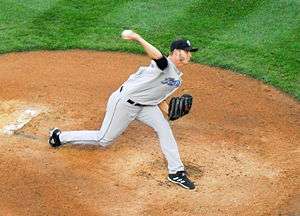
The 2007 season was blighted by persistent injuries, with 12 Blue Jays landing on the disabled list. The most serious injury was that of B. J. Ryan, who was out for the entire season having had Tommy John surgery. Prior to the season, the team signed starting pitchers John Thomson, Tomo Ohka, and Víctor Zambrano; each of them was released before the end of the season. However, young starters Shaun Marcum and Dustin McGowan had break-out years, with 12 wins each. On June 24, McGowan pitched a complete game one-hitter. On June 28, Frank Thomas became the 21st major league player to hit 500 career home runs. Aaron Hill also had a break-out year, setting a team record for second baseman with 47 doubles.
- Team record 2007: 83 wins–79 losses, W%- 0.512, 13 games behind division leader, third in division
2008 season
The Blue Jays' 2008 season featured a strong pitching staff, which led the major leagues with a 3.49 ERA. For much of the season, however, the team struggled to hit home runs and drive in runs. On May 24, starter Jesse Litsch set a team record, with 38 consecutive innings without giving up a walk. On June 20, following a five-game losing streak and with the Jays in last place in the AL East, management fired John Gibbons and several members of his coaching staff, and re-hired Cito Gaston. Meanwhile, Alex Ríos had 32 stolen bases, making him the first Blue Jay with 30 since 2001. On September 5, Roy Halladay earned his 129th career win, moving him into second spot on Toronto's all-time wins list. Halladay also came second in the voting for the Cy Young Award, after posting a 20–11 record and 2.78 ERA.
- Team record 2008: 86 wins–76 losses, W%- 0.531, 11 games behind division leader, fourth in division
2009 season
.jpg)
The 2009 season saw the addition of two new patches on the Blue Jays' uniforms: on the right arm, a bright red maple leaf (part of the Canadian flag), and on the left arm, a small black band with "TED" written on it, in reference to the late team owner Ted Rogers, who died in the off-season.
On Opening Day at the Rogers Centre, the Blue Jays, led by Roy Halladay, beat the Detroit Tigers 12–5. Aaron Hill and Roy Halladay both had excellent years and represented the Blue Jays at the 2009 All-Star Game in St. Louis. The Jays started the season well, posting a 27–14 record, however immediately afterwards the Jays fell into a nine-game losing streak and was never able to recover for the remainder of the season. In mid-August, GM J. P. Ricciardi allowed the Chicago White Sox to claim Alex Ríos off waivers. With two games remaining in what was a disappointing season, Ricciardi was fired on October 3. He was replaced by assistant general manager Alex Anthopoulos.[11][12]
Despite a 75-win season, the Jays saw the strong return of Aaron Hill, who won the American League Comeback Player of the Year Award and the Silver Slugger for second base. Adam Lind, who also had a strong season, earned the Silver Slugger for designated hitter.
- Team record 2009: 75 wins–87 losses, W%- 0.463, 28 games behind division leader, fourth in division
2010–2015: The Alex Anthopoulos and José Bautista era
2010 season
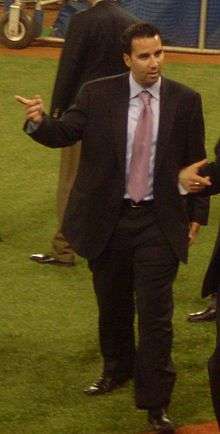
In the off-season, the Jays' ace Roy Halladay was traded to the Philadelphia Phillies for Kyle Drabek, Travis d'Arnaud, and Michael Taylor; Taylor was immediately traded to the Oakland Athletics for Brett Wallace. The team's significant free agent signings were that of catcher John Buck and shortstop Álex González.[13]
The 2010 season was a surprising 10-win improvement over the last season. It was a career year for José Bautista, who hit 54 home runs, breaking George Bell's franchise record of 47. In doing so, he became the 26th player to reach 50 home runs and the first since Alex Rodriguez and Prince Fielder achieved the feat in 2007. The Blue Jays also set a franchise record for the most home runs in a single season as they hit 257, 13 more than their previous record of 244 set by the 2000 Blue Jays. The Blue Jays tied the 1996 Baltimore Orioles for the third most home runs by a team in a single season. Seven players (José Bautista, Vernon Wells, Aaron Hill, Adam Lind, Lyle Overbay, John Buck, and Edwin Encarnación) hit 20 home runs or more throughout the season, tying an MLB record previously set by four teams, including the 2000 Blue Jays.
On July 14, the Jays traded Álex González and two minor league prospects—left-handed pitcher Tim Collins and shortstop Tyler Pastornicky—to the Atlanta Braves for Jo-Jo Reyes and Yunel Escobar.
On August 7, catching prospect J. P. Arencibia made his major league debut. He went 4-for-5 with two home runs, including a home run hit on the first pitch he saw. The next day, starting pitcher Brandon Morrow came within one out of a no-hitter, finishing with 17 strikeouts in a complete game one-hitter.
- Team record 2010: 85 wins–77 losses, W%- 0.525, 11 games behind division leader, fourth in division
2011 season
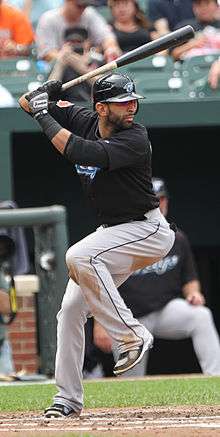
Led by new manager John Farrell, the 2011 Blue Jays finished with a .500 record. After signing a five-year $64 million contract extension,[14] José Bautista followed up his record-setting 2010 season with an arguably better season. He finished with a Major League-leading 43 home runs, along with 103 RBI, 132 walks, and a .302 average. Rookie J. P. Arencibia also had a successful year, setting a Blue Jays single-season record with 23 home runs by a catcher. In August, third base prospect Brett Lawrie made his Major League debut and hit .293 with 9 home runs, 4 triples, and 25 RBI, in just 43 games.
Starting pitcher and ace Ricky Romero led the team with 15 wins and a 2.92 ERA. He also became an All-Star for the first time in his career. The other starting pitchers were inconsistent, and Farrell used 12 different starters over the course of the season.[15] Jon Rauch and Frank Francisco, both acquired in the off-season, shared the closer role.[16] They both struggled through the first half of the season, though Francisco improved in the last two months of the season, and had six saves in September.
On July 31, the Blue Jays retired their first number, Roberto Alomar's #12, one week after Alomar became the first Hall of Famer to be inducted as a Blue Jay.[17]
- Team record 2011: 81 wins–81 losses, W%- 0.500, 16 games behind division leader, fourth in division
2012 season
The 2012 season was an injury-plagued year for the Blue Jays, having used 31 total pitchers, which set a franchise record.[18] In June, three starting pitchers (Brandon Morrow, Kyle Drabek, and Drew Hutchison) were lost to injury in a span of four days, two of whom required Tommy John surgery;[18] in addition, starters Dustin McGowan and Jesse Litsch missed the entire season due to injury. In the second half of the season, some key players in Toronto's line-up, including All-Star José Bautista, missed a significant amount of playing time due to injury, sending the team into a freefall and culminating in a 73–89 record. Despite the underachievements of Ricky Romero and Adam Lind, Casey Janssen established himself as a reliable closer (22 SV, 2.52 ERA) and Edwin Encarnación developed into one of the league's best power hitters (.280 AVG, 42 HR, 110 RBI).
On 5 April 2012 the team opened on the road in Cleveland, where they beat the Indians 7–4 in 16 full innings,during this game they set the record of the longest opening-day game in the Major League history.The previous record of 15 innings had been set by the Washington Senators and Philadelphia Athletics on April 13, 1926, and tied by the Detroit Tigers and the Indians on April 19, 1960.[19]
On April 20, the Jays turned a triple play against the Kansas City Royals in a 4–3 win. It was the first triple play they turned since September 21, 1979.[20]
- Team record 2012: 73 wins–89 losses, W%- 0.451, 22 games behind division leader, fourth in division
2013 season
During the offseason, the Toronto Blue Jays traded Farrell to the Boston Red Sox per his wishes, and former manager John Gibbons returned to manage the Blue Jays. The Jays also made a blockbuster trade with the Miami Marlins, leading to a series of other blockbuster trades and signings, including with the New York Mets for National League Cy Young winner R.A. Dickey and free agents including Melky Cabrera. On June 8, the Blue Jays played the then-longest game in franchise history by innings, winning 4–3 in 18 innings against the visiting Texas Rangers, which would be broken one season later.[21] The Jays matched their franchise record of 11 consecutive wins in a 13–5 home win over the Baltimore Orioles on June 23.[22] However, the Jays had a losing season overall.
- Team record 2013: 74 wins–88 losses, W%- 0.457, 23 games behind division leader, fifth in division, 17.5 games behind AL wild card cutoff, eighth in AL wild card
2014 season
Pitcher Roy Halladay signed a one-day contract with the Blue Jays before retiring from baseball, citing injuries. The Jays had a nine-game win streak from May 20 to 28, as well as wins in 18 of 21 between May 15 and June 6. On August 10, the Blue Jays played the longest game in franchise history by both time and innings, winning 6–5 in 19 innings and playing 6 hours, 37 minutes against the visiting Detroit Tigers.[23]
- Team record 2014: 83 wins–79 losses, W%- .512, 13 games behind division leader, third in division, 5 games behind AL wild card cutoff, sixth in AL wild card
2015: Return to the playoffs, AL East champions
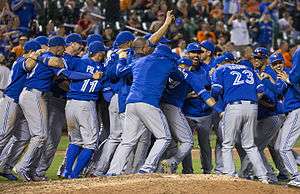
During the off-season, the Jays signed Toronto-born catcher Russell Martin[24] through free agency. The Jays acquired Marco Estrada,[25] Devon Travis,[26] All-Star third baseman Josh Donaldson,[27] and Michael Saunders[28] in trades. The Jays claimed Justin Smoak,[29] Andy Dirks,[30] and Chris Colabello off waivers.[31] However, Dirks, along with John Mayberry Jr., were eventually non–tendered; the Jays later signed Dirks to a minor league contract.[32] Melky Cabrera[33] and Brandon Morrow[34] left through free agency and Juan Francisco was claimed off waivers by the Boston Red Sox.[35]
The Jays later traded José Reyes and pitching prospects Miguel Castro, Jeff Hoffman, and Jesus Tinoco to the Colorado Rockies for All-Star shortstop Troy Tulowitzki and reliever LaTroy Hawkins. Two days later, they acquired All-Star pitcher David Price from the Detroit Tigers in exchange for pitching prospects Daniel Norris, Matt Boyd, and Jairo Labourt.
The Jays had two 11-game winning streaks during this season. On September 25, the Blue Jays clinched a playoff berth, ending the longest active playoff drought in North American professional sports (see List of Major League Baseball franchise postseason droughts).[36] They subsequently claimed the AL East division title on September 30, after defeating the Baltimore Orioles 15–2 in the first game of a doubleheader.[37]
The Blue Jays faced the Texas Rangers in the ALDS. After losing back-to-back home games, they won the next three games in a row to take the five-game series, advancing to the ALCS; a three-game comeback series victory had not been accomplished since 2012 by the San Francisco Giants.[38]
The Blue Jays then faced the Kansas City Royals in the ALCS, losing the series 4–2 in Kansas City; the Royals would eventually win the World Series.[39]
After the playoffs, Donaldson was named AL MVP, becoming the first Blue Jay to win the award since George Bell in 1987.
- Team record 2015: 93 wins–69 losses, W%- .574
2016–present: The Ross Atkins and Josh Donaldson era
2016 season

Upon the expiration of Paul Beeston's contract, Mark Shapiro replaced him as president of the Blue Jays. Alex Anthopoulos resigned two months after the hiring of Shapiro. Ross Atkins subsequently took his place.
During the off-season, David Price left the Blue Jays through free agency, signing with the Boston Red Sox, while the Blue Jays signed J. A. Happ.
On March 4, 2016, infielder Maicer Izturis announced his retirement from baseball. A few weeks later, Brad Penny and Rafael Soriano, both veterans under minor league contract with the Blue Jays, retired from baseball as well.
On May 15, 2016, the Blue Jays and the Texas Rangers brawled against each other in Arlington, Texas. The brawl happened when Matt Bush threw a pitch at Jose Bautista, then Bautista made an illegal slide, and Rougned Odor punched Bautista. Bautista was later suspended for one game.
On May 31, 2016, the Blue Jays traded for Jason Grilli from the Atlanta Braves.
Before the non-waiver trade deadline at 4 pm EDT on August 1, 2016, the Blue Jays traded for Joaquín Benoit, Melvin Upton Jr., Scott Feldman, and Francisco Liriano.
On August 25, 2016, the Blue Jays re-acquired popular backup catcher Dioner Navarro in a trade with the Chicago White Sox. This was done before the August 31st trade deadline making Navarro eligible to be on the postseason roster.
On October 2, 2016, the Blue Jays clinched their first Wild Card berth with a Detroit Tigers loss to the Atlanta Braves.
On October 4, 2016, the Blue Jays defeated the Baltimore Orioles in the American League Wild Card Game in extra innings, via a walk-off three-run home run by Edwin Encarnación in the bottom of the 11th inning.
On October 9, 2016, the Blue Jays completed a sweep of the Texas Rangers in the American League Division Series to advance to the American League Championship Series for the second consecutive year.
On October 19, 2016, the Blue Jays were eliminated from World Series contention with a 3–0 loss to the Cleveland Indians in Game 5 of the American League Championship Series.
- Team record 2016: 89 wins–73 losses, W%- .549
2017 season
On November 11, 2016, it was announced that Toronto signed designated hitter Kendrys Morales signed a three-year, $33 million deal.[40] The contract became official on November 18.[41]
Popularity
(in millions of US dollars) |
|---|
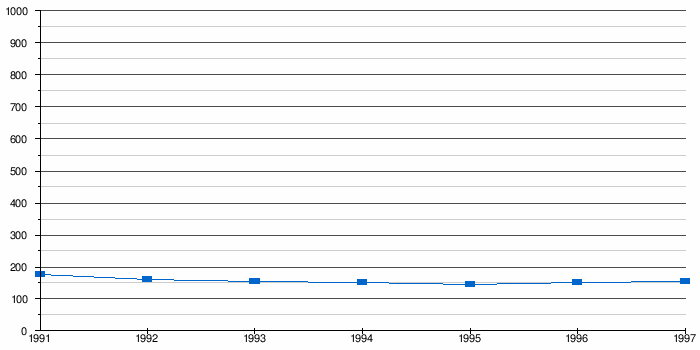 |
(in millions of US dollars) |
|---|
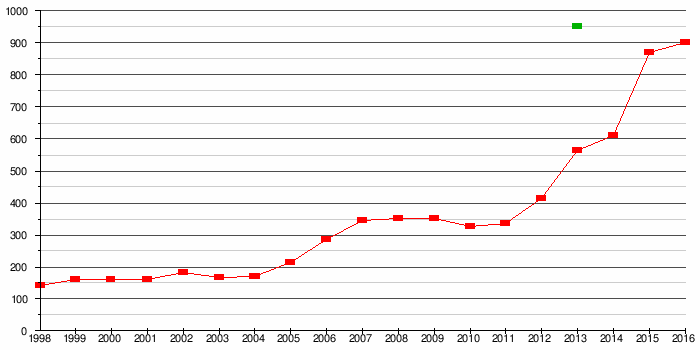 |
| Note: Unlike the Forbes valuations, Bloomberg includes contributions from regional sports networks and related businesses in the total value.[45] |
In 1977, after just 50 home games, the Blue Jays set an MLB record for a first-year expansion team, with an overall attendance of 1,219,551 during those games.[46] By the end of the season, 1,701,152 fans had attended. In 1991, the Blue Jays became the first MLB team to attract over four million fans, with an attendance of 4,001,526, followed by 4,028,318 in 1992.[4] Each of those records were broken in 1993 by the expansion Colorado Rockies, although the Blue Jays' 1993 attendance of 4,057,947 stood as an AL record for 12 years until it was broken by the 2005 New York Yankees.[47]
Several Blue Jays became very popular in Toronto and across the major leagues, starting with Dave Stieb, whose seven All-Star selections is a franchise record. He is closely followed by Roy Halladay and José Bautista, who were selected six times each, and by Roberto Alomar and Joe Carter, who were selected five times each. Bautista set a major league record in 2011 (which only stood for just one year), with 7,454,753 All-Star votes.[48] In his first season with the Blue Jays in 2015, Josh Donaldson set a new major league record by receiving 14,090,188 All-Star votes.[49]
Culture
"OK Blue Jays"
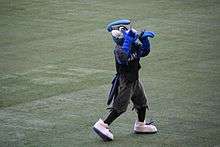
During the seventh-inning stretch of home games, before singing "Take Me Out to the Ball Game", Blue Jay fans sing and clap to "OK Blue Jays" by Keith Hampshire and The Bat Boys, which was released in 1983. The song was remixed in 2003, and since then, the new shortened version is played at home games.
Mascots
From 1979 to 1999, BJ Birdy served as the Blue Jays' sole mascot, played by Kevin Shanahan. In 2000, he was replaced by a duo named Ace and Diamond. After the 2003 season, Diamond was removed by the team, leaving Ace as the team's sole mascot. Since the 2010s, Ace has been accompanied by his younger brother, Junior. This usually happens on Jr. Jay Saturdays.
Rivalries
Montreal Expos
The Montreal Expos were the Blue Jays' geographic National League rival, being the other Canadian MLB team before it was relocated. From 1978 to 1986, the teams played an annual mid-season exhibition game, known as the Pearson Cup, named after former Prime Minister Lester B. Pearson. The teams began facing each other in the regular season in 1997, with the advent of interleague play. During the 2003 and 2004 seasons, the Expos' last two seasons before relocating to Washington, D.C. as the Nationals, the Pearson Cup was awarded after a pair of three-game sets.
Detroit Tigers
The Detroit Tigers are the Blue Jays' geographic and traditional rival, dating back to the 1980s, when the teams were AL East contenders. The Tigers moved to the AL Central in 1998, and the rivalry has died down as a result, with the teams facing each other only six to seven times per year since 2011.[50] The Blue Jays have an all-time record of 223–190 against the Tigers, as of the end of 2016.[51]
Radio and television
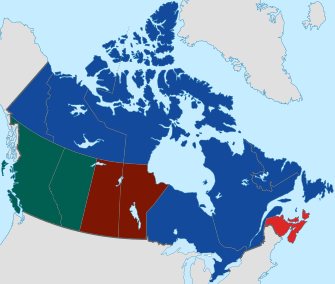
Radio
The Blue Jays' former radio play-by-play announcer, Tom Cheek, called every Toronto Blue Jays game from the team's inaugural contest on April 7, 1977 until June 3, 2004, when he took two games off following the death of his father — a streak of 4,306 consecutive regular season games and 41 postseason games. Cheek later died on October 9, 2005 and the team commemorated him during their 2006 season by wearing a circular patch on the left sleeve of their home and road game jerseys. The patch was adorned with the letters 'TC', Cheek's initials, as well as a stylized microphone. Cheek is also honoured with a place in the Blue Jays' "Level of Excellence" in the upper level of the Rogers Centre; the number 4,306 is depicted beside his name. In 2008, Cheek received the third most votes by fans to be nominated for the Ford C. Frick Award for broadcasting excellence. Cheek finally received the Frick Award, posthumously, in 2013 after nine years on the ballot.[52]
Radio broadcasts of Blue Jays games are originated from Sportsnet 590 CJCL in Toronto which, like the Blue Jays, is owned by Rogers Communications. Jerry Howarth, Cheek's longtime broadcasting partner, is the lead play-by-play announcer, with Mike Wilner as the secondary play-by-play announcer. During the 2007 to 2012 seasons, former Blue Jays catcher Alan Ashby was the colour commentator. Former Blue Jays pitcher Jack Morris served as the colour commentator during the 2013 season, after which he was replaced by former Montreal Expos catcher Joe Siddall.
Former Blue Jays pitcher Dirk Hayhurst filled in for Morris for some games during the 2013 season.
Another former catcher for the Blue Jays, Gregg Zaun, has served as the occasional colour commentator since the 2011 season.
Joe Siddall took over the colour commentator role for the 2014 season and returned for the 2015 season.
The Toronto Blue Jays have the largest geographical home market in all of baseball, encompassing all of Canada. Despite this, the number of radio stations that broadcast games is actually quite small. Only twenty radio stations across the country aired at least some Blue Jays games during the 2011 season,[53] which is fewer affiliates than most teams.
Television
All Blue Jays games are carried nationally on Sportsnet (which, like the Blue Jays, is owned by Rogers Communications), with Buck Martinez as the play-by-play announcer,[54] and Pat Tabler as the primary colour analyst. On select games, play-by-play is handled by Dan Shulman, with Martinez and Tabler on commentary.[55] Toronto Raptors play-by-play announcer Matt Devlin has also filled in for Martinez in a select number of games. In previous years, the colour analyst role rotated between Pat Tabler, Rance Mulliniks, Darrin Fletcher, and since the 2011 season, Gregg Zaun. Sportsnet became the team's primary carrier soon after it launched in the late 1990s, and became the team's exclusive broadcaster in 2010.[56] As of August 2010, Sportsnet One also broadcasts Blue Jays games (often in case of scheduling conflicts with the main Sportsnet channels). Rogers was however, criticized by fans and critics due to Sportsnet One only being carried by Rogers Cable systems on launch.[57]
In September 2012, AMI-tv simulcast three Blue Jays games with described video provided by CJCL correspondent Sam Cosentino, which included explanations of on-screen graphics. Paul Beeston praised AMI's involvement, stating that "to our knowledge, we are the first sports organization to have our games provided through this revolutionary approach to accommodating the needs of the blind and low-vision community."[58] On June 27, 2013, Rogers' over-the-air Toronto multicultural station Omni.2 simulcast a Blue Jays game (in which Taiwanese player Chien-Ming Wang was scheduled to start) with commentary in Mandarin, marking the first ever Canadian MLB broadcast in the language.[59][60] TVA Sports has aired games in French since 2011, with Jacques Doucet on play-by-play and Rodger Brulotte on colour.
Sportsnet's broadcasts of the 2015 American League Division Series involving the Blue Jays were among the highest-rated telecasts in network history, with Game 4 drawing an audience of 4.38 million viewers.[61]
The Sports Network (TSN), which (like the Jays) was owned by Labatt from 1984 to 1995, served as the primary cable television outlet for the Blue Jays prior to the launch of Sportsnet. TSN (and later, its sister channel TSN2) continued to carry approximately ten Jays games through the 2009 season until May 2010; most recently, Rod Black handled play-by-play while Tabler served as colour commentator on these telecasts. CBC has carried Blue Jays games intermittently throughout the team's history, most recently in 2007 and 2008; those broadcasts featured Jim Hughson as the play-by-play announcer, and former Blue Jays Rance Mulliniks and Jesse Barfield on colour commentary.[62] Games also aired on CTV (except in Montreal) from the team's inception until the late 1990s. The Blue Jays have not appeared over-the-air in Canada in English since 2008.
In 2008, Rogers Communications, owner of the Jays, was granted a license by the Canadian Radio-Television Commission (CRTC) to launch a specialty channel, to be named "Baseball TV".[63] The channel would have been dedicated to coverage of baseball, combining content from the United States-based MLB Network with original Canadian content.[64] However, the channel was never launched, and instead Rogers sponsored an application by the US version of MLB Network to be made available to Canadian distributors, which was approved by the CRTC.[65][66]
Current roster
| Toronto Blue Jays 2017 spring training roster | |||||||||
|---|---|---|---|---|---|---|---|---|---|
| 40-man roster | Non-roster invitees | Coaches/Other | |||||||
|
Pitchers
|
Catchers
Infielders
Outfielders
Designated hitters |
Pitchers
Catchers
|
Manager Coaches
| ||||||
Minor league affiliations
| Level | Team | League | Location |
|---|---|---|---|
| AAA | Buffalo Bisons | International League | Buffalo, New York[67] |
| AA | New Hampshire Fisher Cats | Eastern League | Manchester, New Hampshire |
| Advanced A | Dunedin Blue Jays | Florida State League | Dunedin, Florida |
| A | Lansing Lugnuts | Midwest League | Lansing, Michigan |
| Short Season A | Vancouver Canadians | Northwest League | Vancouver, British Columbia |
| Rookie-Advanced | Bluefield Blue Jays | Appalachian League | Bluefield, Virginia/West Virginia |
| Rookie | GCL Blue Jays | Gulf Coast League | Dunedin, Florida |
| DSL Blue Jays | Dominican Summer League | San Pedro de Macorís, Dominican Republic |
Season by season record
Awards and other achievements
Award winners and league leaders
Franchise records
| Statistic | Single season record | Career record | |||
|---|---|---|---|---|---|
| Player | Record | Season | Player | Record | |
| Games played: | Tony Fernández | 163 | 1986 | Tony Fernández | 1,450 |
| Plate appearances: | Vernon Wells | 735 | 2003 | Carlos Delgado | 6,018 |
| At bats: | Tony Fernández | 687 | 1986 | Vernon Wells | 5,470 |
| Batting average: | John Olerud | .363 | 1993 | Roberto Alomar | .307 |
| On-base percentage: | John Olerud | .473 | 1993 | John Olerud | .395 |
| Slugging percentage: | Carlos Delgado | .664 | 2000 | Carlos Delgado | .556 |
| On-base plus slugging: | Carlos Delgado | 1.134 | 2000 | Carlos Delgado | .949 |
| Runs scored: | Shawn Green | 134 | 1999 | Carlos Delgado | 889 |
| Hits: | Vernon Wells | 215 | 2003 | Tony Fernández | 1,583 |
| Total bases: | Carlos Delgado | 378 | 2000 | Carlos Delgado | 2,786 |
| Doubles: | Carlos Delgado | 57 | 2000 | Carlos Delgado | 343 |
| Triples: | Tony Fernández | 17 | 1990 | Tony Fernández | 72 |
| Home runs: | José Bautista | 54 | 2010 | Carlos Delgado | 336 |
| RBI | Carlos Delgado | 145 | 2003 | Carlos Delgado | 1,058 |
| Walks: | José Bautista | 132 | 2011 | Carlos Delgado | 827 |
| Stolen bases: | Dave Collins | 60 | 1984 | Lloyd Moseby | 255 |
| Games played (pitcher): | Mark Eichhorn | 89 | 1987 | Jason Frasor | 505 |
| Games started: | Jim Clancy | 40 | 1982 | Dave Stieb | 408 |
| Wins: | Roy Halladay | 22 | 2003 | Dave Stieb | 175 |
| Losses: | Jerry Garvin Phil Huffman | 18 | 1977 1979 | Jim Clancy | 140 |
| Winning percentage: | Dennis Lamp | 1.000 | 1985 | Roger Clemens | .759 |
| Innings pitched: | Dave Stieb | 288.1 | 1982 | Dave Stieb | 2873 |
| ERA: | Mark Eichhorn | 1.72 | 1986 | Tom Henke | 2.48 |
| Earned runs: | Erik Hanson | 129 | 1996 | Dave Stieb | 1,091 |
| Strikeouts: | Roger Clemens | 292 | 1997 | Dave Stieb | 1,658 |
| Complete Games: | Dave Stieb | 19 | 1982 | Dave Stieb | 102 |
| Shutouts: | Dave Stieb | 5 | 1982 | Dave Stieb | 30 |
| Saves: | Duane Ward | 45 | 1993 | Tom Henke | 217 |
| [68][69] | |||||
Triple crown champions
Roger Clemens won the pitching triple crown in 1997 and 1998.[70]
Baseball Hall of Famers
Six former Blue Jays, one former manager, and one former general manager, have been elected into the Baseball Hall of Fame. Second baseman Roberto Alomar, elected to the Hall of Fame in 2011, is the first player to be inducted based primarily on service as a Blue Jay.
| Toronto Blue Jays Hall of Famers | |||||||||
|---|---|---|---|---|---|---|---|---|---|
| Affiliation according to the National Baseball Hall of Fame and Museum | |||||||||
|
Bobby Doerr, a second baseman with the Boston Red Sox, served as a coach with the Jays early in their history, and was the first person associated with the franchise to be elected to the Hall, in 1986. Early Wynn, the Hall of Fame pitcher and 300-game winner, was a broadcaster for the Blue Jays during their first few years.
Ford C. Frick Award recipients
| Toronto Blue Jays Ford C. Frick Award recipients | |||||||||
|---|---|---|---|---|---|---|---|---|---|
| Affiliation according to the National Baseball Hall of Fame and Museum | |||||||||
|
J. G. Taylor Spink Award recipients
| Toronto Blue Jays J. G. Taylor Spink Award recipients | |||||||||
|---|---|---|---|---|---|---|---|---|---|
| Affiliation according to the National Baseball Hall of Fame and Museum | |||||||||
| |||||||||
Retired numbers
|
Soon after being the first person to be inducted in the Hall of Fame as a Blue Jay, on July 31, 2011, second baseman Roberto Alomar was the first person to have his number retired by the Blue Jays.[72]
Level of Excellence
The team has also instituted a "Level of Excellence" on the 400 level of the Rogers Centre, where the following Jays personnel are honoured:
Tony Fernández SS, 3B: 1983–1990, 1993, 1998–1999, 2001 |
George Bell LF: 1981–1990 |
Roberto Alomar 2B: 1991–1995 |
Carlos Delgado 1B: 1993–2004 |
Joe Carter RF, 1B: 1991–1997 |
Dave Stieb P: 1979–1992, 1998 |
Cito Gaston Manager: 1989–1997, 2008–2010 |
Tom Cheek Broadcaster: 1977–2005 |
Paul Beeston VP: 1976–1989; President: 1989–1997, 2008–2015 |
Pat Gillick GM: 1978–1994 |
Players' uniform numbers were listed—and in Tom Cheek's case, the number of consecutive games he called for the Blue Jays[73]—until the 2013 All-Star Break, even though, with the exception of Roberto Alomar's, these numbers have not been retired. During the 2013 All-Star Break, the Level of Excellence was redesigned for the addition of Carlos Delgado's name. The redesign removed all uniform numbers from the Level of Excellence aside from Roberto Alomar's retired #12 and Tom Cheek's 4306 for his consecutive games called streak.[74]
References
- ↑ "The "Blue" is back in Blue Jays" (Press release). Toronto Blue Jays. November 18, 2011. Retrieved July 1, 2016.
- ↑ "Front Office Directory". Major League Baseball Advanced Media. Toronto Blue Jays. October 1, 2015. Retrieved October 1, 2015.
- ↑ Chisholm, Gregor (November 18, 2011). "Blue Jays unveil new logo for 2012 season". Toronto Blue Jays. Retrieved October 1, 2015.
- 1 2 3 4 Blue Jays Timeline BlueJays.com. Accessed on December 7, 2011.
- ↑ Braun, Wayne; Brehl, Jack (1985). The Drive of '85: A Salute to the Blue Jays by the Toronto Star. Doubleday Canada. ISBN 978-0-385-25037-5.
- ↑ 1943 St. Louis Cardinals Baseball-Reference.com. Accessed on June 13, 2014.
- ↑ "October 24, 1992 World Series Game 6 at Atlanta–Fulton County Stadium Play by Play and Box Score". Baseball-Reference.com. October 24, 1992. Retrieved February 19, 2011.
- ↑ 1893 National League Batting Leaders Baseball-Reference.com. Accessed on May 29, 2012.
- ↑ "Ted Rogers buys The Blue Jays". CBC News. 2000-09-01. Retrieved 2013-12-28.
- ↑ Bastian, Jordan (July 2, 2006). "Five Jays named to AL All-Star squad". MLB. Retrieved June 18, 2007.
- ↑ Blue Jays Announce That Ricciardi Is Leaving Club Immediately TSN. Accessed on October 3, 2009.
- ↑ Bastian, Jordan (October 3, 2009). "Ricciardi out as Blue Jays GM". MLB. Retrieved October 3, 2009.
- ↑ Jordan Bastian / MLB.com. "Blue Jays ink shortstop Gonzalez". Toronto Blue Jays. MLB. Retrieved February 19, 2011.
- ↑ BLUE JAYS ANNOUNCE FIVE-YEAR, $64M DEAL WITH BAUTISTA TSN. Accessed on February 23, 2011.
- ↑ "Spring preview: Rotation key for Blue Jays". USA Today. January 25, 2011. Retrieved March 12, 2012.
- ↑ "Blue Jays acquire Francisco in exchange for Napoli". Tsn.ca. January 25, 2011. Retrieved February 19, 2011.
- ↑ Zwelling, Arden (December 12, 2012), "Game Changers: The New Blue Jays", Sportsnet Magazine
- 1 2 "A season to forget in Blue Jay land". The Globe and Mail. October 2, 2012.
- ↑ "Blue Jays outlast Indians in 16-inning marathon opener". CBC Sports. April 5, 2012.
- ↑ Blue Jays turn triple play in 4-3 win over Kansas City Royals Toronto Star. Accessed on April 22, 2012.
- ↑ Kennedy, Brendan (June 8, 2013). "Toronto Blue Jays win longest game in 18 innings". TheStar.com. Retrieved June 8, 2013.
- ↑ Chisholm, Gregor (June 23, 2013). "Blowout win puts Blue Jays firmly in AL East race". MLB.com. Retrieved June 23, 2013.
- ↑ "Detroit Tigers at Toronto Blue Jays – August 10, 2014". MLB.com. Retrieved August 10, 2014.
- ↑ MacLeod, Robert (November 18, 2014). "Blue Jays make Russell Martin signing official". Globe and Mail. Retrieved December 16, 2014.
- ↑ Lott, John (November 1, 2014). "Toronto Blue Jays trade Adam Lind, GM hopes it will pave the way for a roster shake-up". National Post. Retrieved December 16, 2014.
- ↑ Kennedy, Brendan (November 12, 2014). "Blue Jays trade Anthony Gose to Tigers". thestar.com. Retrieved December 16, 2014.
- ↑ Kennedy, Brendan (November 28, 2014). "Blue Jays trade Brett Lawrie to A's for Josh Donaldson". Toronto Star. Retrieved December 16, 2014.
- ↑ Stark, Jayson (December 3, 2014). "J.A. Happ traded to Mariners". ESPN. Retrieved December 16, 2014.
- ↑ Divish, Ryan (October 28, 2014). "Justin Smoak claimed off waivers by the Blue Jays". Seattle Times. Retrieved December 16, 2014.
- ↑ "Blue Jays add Andy Dirks, Jeff Francis". Toronto Sun. October 31, 2014. Retrieved December 16, 2014.
- ↑ "Toronto Blue Jays claim first baseman and outfielder Chris Colabello off waivers". National Post. Canadian Press. December 8, 2014. Retrieved December 16, 2014.
- ↑ "Blue Jays make Andy Dirks, John Mayberry Jr and Justin Smoak free agents". Globe and Mail. Associated Press. December 3, 2014. Retrieved December 16, 2014.
- ↑ Sullivan, Paul (December 15, 2014). "Melky Cabrera deal official: $42 million from White Sox over 3 years". Chicago Tribune. Retrieved December 16, 2014.
- ↑ Kennedy, Brendan (December 16, 2014). "Oft-injured Blue Jays starter Brandon Morrow signs with San Diego Padres". Toronto Star. Retrieved December 16, 2014.
- ↑ Kennedy, Brendan (November 19, 2014). "Red Sox claim Juan Francisco on waivers from Blue Jays". Toronto Star. Retrieved December 16, 2014.
- ↑ Kennedy, Brendan (September 25, 2015). "Toronto Blue Jays clinch playoff spot for first time in 22 years". thestar.com. Retrieved September 26, 2015.
- ↑ http://www.sbnation.com/mlb/2015/9/30/9428603/toronto-blue-jays-american-league-east-champions-2015
- ↑ http://www.sportsnet.ca/baseball/mlb/blue-jays-advance-to-alcs-after-emotional-win-over-rangers/
- ↑ http://www.cbc.ca/news/canada/toronto/blue-jays-season-ends-1.3287101
- ↑ "Report: Blue Jays sign Kendrys Morales to three-year deal".
- ↑ Kruth, Cash (November 18, 2016). "Blue Jays announce signing of slugger Morales". MLB.com. Retrieved November 18, 2016.
- ↑ Data from the following annual reports:
- Baldo, Anthony; Biesada, Alexandra; Hackney, Holt; Ozanian, Michael K; Taub, Stephen (1991-07-09). "Secrets of the front office: What America's pro teams are worth". Financial World: 28.
- Ozanian, Michael K; Taub, Stephen; Morris, Kathleen; Fink, Ronald (1992-07-07). "Big leagues, bad business". Financial World: 34.
- Ozanian, Michael K; Taub, Stephen; Fink, Ronald; Kimelman, John; Reingold, Jennifer; Starr, Jason (1993-05-25). "Foul ball". Financial World: 50.
- Ozanian, Michael K; Fink, Ronald; Kimelman, John; Reingold, Jennifer; Osterland, Andrew; Starr, Jason; Grabarek, Brooke (1994-05-10). "The $11 billion pastime: Why sports franchise values are soaring even as team profits fall". Financial World: 50.
- Ozanian, Michael K; Atre, Tushar; Fink, Ronald; Reingold, Jennifer (1995-05-09). "Suite deals: Why new stadiums are shaking up the pecking order of sports franchises". Financial World: 42.
- Atre, Tushar; Auns, Kristine; Badenhausen, Kurt; McAuliffe, Kevin (1996-05-20). "The high-stakes game of team ownership". Financial World: 49.
- Badenhausen, Kurt; Nikolov, Christopher (1997-06-17). "More than a game: An in-depth look at the raging bull market in sports franchises". Financial World: 40.
- ↑ "Toronto Blue Jays". Forbes. March 2014. Retrieved 2014-06-03.
- ↑ "#20 Toronto Blue Jays". Forbes. 2007-04-19. Retrieved 2014-06-03.
- 1 2 "Major League Baseball Franchise Valuations". Bloomberg L.P. 2013-10-23. Retrieved 2014-06-03.
- ↑ Blue Jays Timeline BlueJays.com. Accessed on December 7, 2011.
- ↑ "Yankees reach four million in tickets sales for second consecutive season". MLB. July 2, 2006. Retrieved December 13, 2011.
- ↑ "Grand slam: Jose Bautista nabs a record number of All-Star votes". Toronto Star. July 3, 2011. Archived from the original on August 26, 2011. Retrieved December 7, 2011.
- ↑ "Donaldson receives most ASG votes in history". MLB. July 8, 2015.
- ↑ Buffery, Steve (June 3, 2014). "Jays-Tigers rivalry isn't what it used to be". torontosun.com. Retrieved June 25, 2015.
- ↑ "Series Records: Toronto Blue Jays against Detroit Tigers". mcubed.net. Retrieved March 16, 2016.
- ↑ Fordin, Spencer. "Cheek's wife accepts Frick Award with moving speech". MLB. Retrieved August 22, 2013.
- ↑ "Blue Jays Radio Network | bluejays.com: Schedule". Toronto Blue Jays. MLB. March 22, 2010. Retrieved February 19, 2011.
- ↑ Jordan Bastian / MLB.com (January 17, 2006). "Martinez joins Jays as play-by-play man | bluejays.com: News". Toronto Blue Jays. MLB. Retrieved February 19, 2011.
- ↑ Gregor Chisholm / MLB.com (November 19, 2015). "Shulman joining Blue Jays' TV broadcast crew". Major League Baseball. MLB. Retrieved May 2, 2016.
- ↑ Blue Jays Now Exclusively on Sportsnet, Blue Jays press release, May 13, 2010
- ↑ Dowbiggun, Bruce. "Pelley will need all his smarts to fix Sportsnet One fiasco". Globe and Mail. Canada. Retrieved August 23, 2010.
- ↑ "Three Blue Jays games to feature described video". bluejays.com. MLB. Retrieved 8 June 2013.
- ↑ "OMNI to air Blue Jays vs Red Sox in Mandarin, Thursday". Citynews.ca. Rogers Media. Retrieved 28 June 2013.
- ↑ "OMNI TV To Air First Mandarin Broadcast of MLB Game in Canada". Broadcaster Magazine. Retrieved 28 June 2013.
- ↑ "Great Canadian Ratings Report: Blue Jays continue to set records for Sportsnet". Yahoo! Sports Canada. Retrieved 16 October 2015.
- ↑ "Mulliniks, Barfield join CBC's Blue Jays booth". Canada: CBC. June 7, 2007. Retrieved June 18, 2007.
- ↑ "Broadcasting Decision CRTC 2008-171" (PDF). Canadian Radio-Television Commission. 2008-08-13. Retrieved 2015-07-02.
- ↑ Houston, William (2009-01-07). "Baseball TV may launch this year". The Globe and Mail. Retrieved 2015-07-02.
- ↑ "Broadcasting Decision CRTC 2012-637". Canadian Radio-Television Commission. 2012-11-21. Retrieved 2015-07-02.
- ↑ "Rogers bids to bring MLB Network to Canada". CBC News. 2012-06-20. Retrieved 2015-07-02.
- ↑ Harrington, Mike (17 September 2012). "Herd signs with Blue Jays for two years". The Buffalo News. Retrieved 18 September 2012.
- ↑ "Toronto Blue Jays Top 10 Batting Leaders". Baseball Reference. Retrieved December 15, 2014.
- ↑ "Toronto Blue Jays Top 10 Pitching Leaders". Baseball Reference. Sports Reference LLC. Retrieved December 15, 2014.
- ↑ "Triple Crown Winners". Baseball Reference. Retrieved December 17, 2014.
- ↑ Carr, Samantha (December 6, 2010). "Emotional Election". National Baseball Hall of Fame and Museum. Retrieved January 5, 2011.
- ↑ "Roberto Alomar's uniform number to be retired by Blue Jays". MLB. Retrieved November 19, 2011.
- ↑ "Level of Excellence". Toronto Blue Jays. Retrieved November 19, 2011.
- ↑ McNeil, Shane (July 20, 2011). "YOUR CALL: SHOULD THE BLUE JAYS RETIRE ANY MORE NUMBERS?". TSN. Retrieved November 19, 2011.
- Some text copied via the GFDL from BR Bullpen article on the 2009 Blue Jays
External links
| Wikimedia Commons has media related to Toronto Blue Jays. |
- Toronto Blue Jays official website
- CBC Digital Archives – Major League Baseball Comes to Canada
- Toronto Blue Jays at DMOZ
- Heritage by the Minute—Toronto Blue Jays
| World Series Champions | ||
| Preceded by: Minnesota Twins 1991 |
1992 & 1993 | Succeeded by: Atlanta Braves 1995 |
| American League Champions | ||
| Preceded by: Minnesota Twins 1991 |
1992 & 1993 | Succeeded by: Cleveland Indians 1995 |
| American League Eastern Division Champions | ||
| Preceded by: Detroit Tigers 1984 |
1985 | Succeeded by: Boston Red Sox 1986 |
| Preceded by: Boston Red Sox 1988 |
1989 | Succeeded by: Boston Red Sox 1990 |
| Preceded by: Boston Red Sox 1990 |
1991 – 1993 | Succeeded by: Boston Red Sox 1995 |
| Preceded by: Baltimore Orioles 2014 |
2015 | Succeeded by: Boston Red Sox 2016 |

